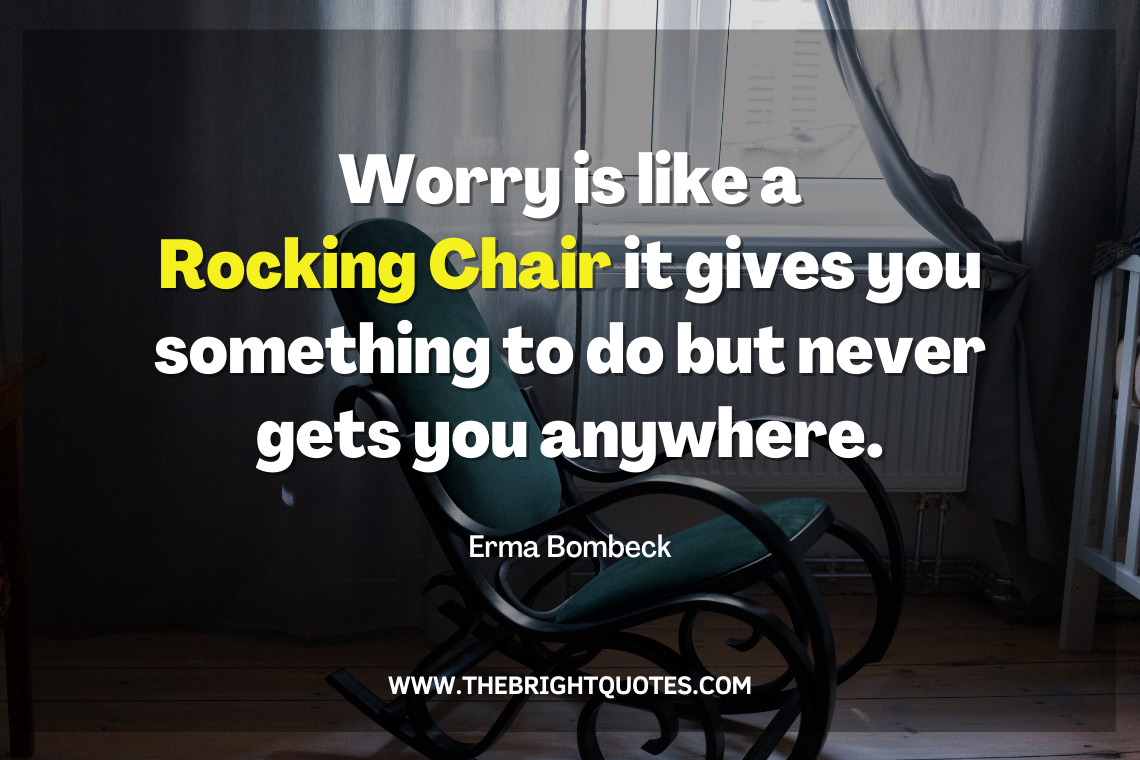The Essence of the Quote

The quote “Worry is like a rocking chair. It gives you something to do, but it doesn’t get you anywhere” is a powerful metaphor that highlights the futility of dwelling on anxieties. It encourages us to recognize that worry, while seemingly occupying our time and energy, ultimately leads to no tangible progress or solutions.
The Metaphor of the Rocking Chair
The quote uses a vivid and relatable metaphor to illustrate the nature of worry. The rocking chair, with its repetitive back-and-forth motion, perfectly captures the essence of worry. Just as a rocking chair provides a sense of activity without actual movement, worry keeps us occupied with our anxieties but doesn’t solve any problems.
Examples of Worry as Repetitive Motion Without Progress
Worry can manifest in various ways, often resembling the repetitive motion of a rocking chair. Here are some examples:
- Constant Rehashing: When we worry, we tend to replay negative scenarios in our minds, endlessly going over the same thoughts and feelings without finding any solutions. This constant mental replay is like the repetitive motion of a rocking chair.
- Overthinking: Worry often involves excessive analysis and contemplation, leading to a cycle of rumination and anxiety. This constant overthinking can feel like being trapped in a rocking chair, stuck in a loop of negative thoughts.
- Procrastination: Worry can paralyze us, making it difficult to take action and move forward. This inaction, fueled by fear and anxiety, resembles the stagnation of a rocking chair, preventing us from making progress.
The Impact of Worry

Worry, while a natural human response to uncertainty, can become a significant burden when excessive. It can consume our thoughts, affect our emotions, and impact our physical health and well-being. Understanding the impact of worry can help us learn to manage it more effectively.
Psychological and Emotional Effects
Excessive worry can have a profound impact on our mental health. It can lead to feelings of anxiety, fear, and restlessness. Worry can also contribute to:
- Insomnia: Worrying thoughts can keep us up at night, making it difficult to fall asleep or stay asleep.
- Difficulty concentrating: When our minds are preoccupied with worry, it can be challenging to focus on tasks or remember information.
- Irritability: Worry can make us easily agitated and prone to outbursts of anger or frustration.
- Depression: Persistent worry can contribute to feelings of sadness, hopelessness, and a loss of interest in activities we once enjoyed.
Impact on Physical Health
Worry is not just a mental state; it can also manifest physically. Chronic worry can lead to:
- Muscle tension: Worry can cause our muscles to tense up, leading to headaches, back pain, and other physical discomfort.
- Digestive issues: Worry can disrupt our digestive system, leading to symptoms like nausea, diarrhea, or constipation.
- Weakened immune system: Chronic stress, including worry, can suppress our immune system, making us more susceptible to illness.
- High blood pressure: Worry can elevate our heart rate and blood pressure, increasing the risk of heart disease and stroke.
Hindered Productivity and Personal Growth
Worry can significantly hinder our ability to achieve our goals and live fulfilling lives.
- Procrastination: Worry can paralyze us, making it difficult to take action and move forward with our plans.
- Missed opportunities: Excessive worry can lead us to avoid new experiences and challenges, preventing us from exploring our potential and growing as individuals.
- Strained relationships: Worry can make us irritable and withdrawn, straining our relationships with loved ones.
Strategies for Managing Worry: Worry Is Like A Rocking Chair Quote

Worry is a natural human emotion, but when it becomes excessive and overwhelming, it can significantly impact our well-being. Managing worry effectively requires a multifaceted approach that involves understanding its root causes, adopting healthy coping mechanisms, and seeking support when needed. This section explores various strategies that can help individuals navigate the challenges of worry and cultivate a more peaceful and balanced life.
Mindfulness Techniques, Worry is like a rocking chair quote
Mindfulness involves paying attention to the present moment without judgment. It helps to create space between our thoughts and emotions, allowing us to observe our worries without getting carried away by them. Engaging in mindfulness practices can help reduce the intensity and frequency of worry.
- Mindful Breathing: This simple technique involves focusing on your breath, noticing the sensation of each inhale and exhale. When you notice your mind wandering, gently bring it back to your breath. Regular practice can help calm your nervous system and reduce anxiety.
- Body Scan Meditation: This practice involves systematically bringing your attention to different parts of your body, noticing any sensations without judgment. It helps to ground you in the present moment and release physical tension associated with worry.
- Mindful Walking: Pay attention to the sensations of your feet on the ground, the movement of your body, and the sights and sounds around you. This practice helps to bring your focus to the present moment and reduce rumination on past or future worries.
Problem-Solving Techniques
Addressing the underlying causes of worry can significantly reduce its impact. Problem-solving techniques involve breaking down worries into manageable steps and taking action to address them.
- Identify the Problem: Clearly define the source of your worry. What specific situation or issue is causing you anxiety?
- Brainstorm Solutions: Generate a list of potential solutions to address the problem. Be creative and consider all possibilities, even if they seem unlikely at first.
- Evaluate Options: Analyze the pros and cons of each solution, considering their feasibility, effectiveness, and potential consequences.
- Choose and Implement: Select the solution that seems most promising and take concrete steps to implement it. Break down large tasks into smaller, manageable steps.
- Evaluate Results: Reflect on the outcome of your actions and make adjustments as needed. If a solution is not working, consider trying a different approach.
Seeking Support
It’s important to recognize that you don’t have to manage worry alone. Reaching out to others for support can provide valuable perspectives, encouragement, and practical assistance.
- Talk to a Trusted Friend or Family Member: Sharing your worries with someone you trust can help you feel less alone and gain a fresh perspective on the situation.
- Seek Professional Help: If your worry is severe or persistent, consider seeking professional help from a therapist or counselor. They can provide specialized support and guidance in managing anxiety and developing coping strategies.
- Join a Support Group: Connecting with others who share similar experiences can provide a sense of community and validation. Support groups offer a safe space to share your struggles, learn from others, and receive encouragement.
Worry is like a rocking chair quote – The saying “worry is like a rocking chair, it gives you something to do but gets you nowhere” perfectly captures the futility of fretting. Instead of rocking back and forth in anxiety, why not embrace a more productive and enjoyable activity like relaxing in a fire pit rocker chair by the crackling flames?
After all, a moment of peace can often be the best antidote to worry.
The saying goes, “worry is like a rocking chair, it gives you something to do but it doesn’t get you anywhere.” But what if your rocking chair was a big easy plastic outdoor rocking chair mushroom , a whimsical and comfortable seat that invites you to relax and let go of your worries?
Perhaps then, the rocking motion could be a gentle reminder to simply be present in the moment, allowing the worries to fade away like the gentle sway of the chair.